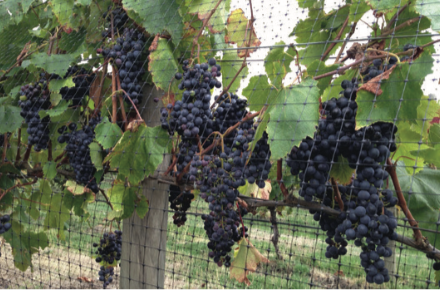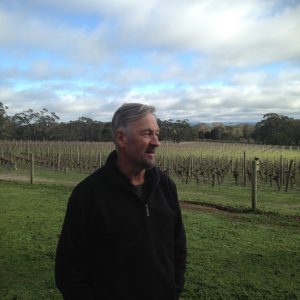By Alan Cooper, Cobaw Ridge, Macedon Ranges, Victoria
First published in the September/October 2015 issue of the Wine & Viticulture Journal
Alan recalls his introduction to Lagrein that led Cobaw Ridge to become the first commercial producer of the variety in Australia, if not outside its native Italy.

Lagrein in the Cobaw Ridge vineyard in Victoria’s Macedon Ranges. We first came upon Lagrein in 1992 via Dr Peter May, a friend that had an interest in all things vine.
We first came upon Lagrein in 1992 via Dr Peter May, a friend that had an interest in all things vine.
At that time Peter was deputy principal of Burnley Horticulture College, in Melbourne. His natural curiosity had led him to plant a hobby vineyard in his backyard, in Kyneton, which among other varieties had 25 vines of Lagrein. He had read about the variety and thought, why not? We recall Peter calling in one day with a mystery bottle of wine for us to try. This was one of a dozen bottles from a micro batch.

Lagrein? Never heard of it. Once we opened it, the light bulb went click! Wow, tell me more!
After tasting that sole initial bottle, in 1993 we made the decision to top graft a few hundred vines and find out more about Lagrein for ourselves. The theory was that if it worked in a less-than-ideal backyard in Kyneton, it should work here (the great Australian can do!) Peter assisted with the cuttings and top grafting.
Back then, there was only one example of true Lagrein being imported into Australia, but it was not the best example. It was much later that we finally got to try a great example which indeed confirmed that we might at least be on the right track.
I recall attending an industry seminar in Melbourne hosted by Richard Smart and, I think, Peter Dry. It was aimed at getting people to think outside of French varieties. At the end of the day there was a wine tasting and people were asked to raise their hand for favourites. I can’t recall what people liked most, but the Lagrein was second. A lot of people were scratching their heads saying, what is it, and where is it from? The wine was Kellerei Gries Riserva.
I was sitting next to Max Allen at the time and I was amused to see him grin and say, “You must be happy with that.” To this day he remains a great supporter. We are certainly the first commercial producer in Australia and as far as our friends in Italy know, we may be the first in the world outside of its native home.
The history of Lagrein can be traced back as far as the 14th century. It is one of two native varieties found in the far north east of Italy. The region is known by the locals as the Sudtirol and was part of Austria up until the Second World War. The dominant language is a local dialect of German.
The food in the region is more Germanic and the road signs feature German with a subtext in Italian. Around 70% of the population are of Tyrollean descent (and are proud of it!)
The Italian population call the area the Alto Adige. The larger area is often called the Trentino-Alto Adige, but in reality it is two quite distinct regions. Trentino is very much Italian, where as the Sudtirol is another world.
The area planted would be around 400 hectares in total. A tiny amount is also grown in the northern part of Trentino. The area is high; most of the vineyards are planted at around 500-600 metres above sea level. The soil type is coarse glacial gravels and is quite sandy. The whole valley faces due south and is a super sun trap. The Italian Alps are to the north and the Dolomites to the south.
Here they make three styles of Lagrein. One is more a drink-now style of lesser quality fruit matured in large, old oak. The second is sometimes a rosé, and the third is the Riserva style; great fruit, gently handled with long maturation in small, quality oak. It is the latter style we aim for. The best examples usually come from the sub-region of Gries, which is situated around the provincial capital of Bozen (Bolzano). These would include the likes of Abtie Muri Gries, Kellerie Gries and Santa Magdalener.
Where we grow Lagrein in the Macedon Ranges is not too different in altitude (610m) and soil type (coarse granite sands) to much of its native home.
Nestled on the Cobaw Ridge, north of the great divide overlooking central Victoria, gives us maximum sunlight exposure, as we have found Lagrein likes a warm site in a cool region.
Most of the vines are on their own roots, cane pruned on an open VSP trellis. We have a small area on rootstock (Teleki 5C), but these have not thrived so are being progressively removed and replanted back to own roots. The original source of the planting material was first imported into Australia in 1969. This, in turn, came from the University in California, Davis, which has lost all records of the original source in Italy.
On our site we find Lagrein ripens late and around the same time as Syrah (mid to late April). Bunches can be quite open and large with thin skins and abundant colour even at quite low ripeness, but does not need super ripeness to achieve full flavour. We would normally pick around 12.5Be. At higher ripeness it becomes quite jammy and has a tendency to become very ‘rustic’.
We are certified organic/biodynamic and are the fifth Australian member of the elite international winemaking group La Renaissance des Appellation (Return to Terroir).
We make the wines with minimal intervention – natural ferments, nil acid, no filtration or fining. Just a minimum of SO2 at bottling is the only addition. Our Lagrein is matured for two years in small French oak. In time we intend to experiment with longer skin contact and more alternative maturation methods, maybe in Qvevri.
The resulting wine is typically dark coloured with bright fruit flavours of dark cherry and is almost aromatic on the nose. Plush, mouthfilling, long tannins persist and are balanced by quite bright natural acidity. Sometimes it can have a trademark slight twist of bitterness on the finish. We find that at 10 years, the wines are still fresh and very attractive.
Over the years we have had some interesting critical comments. Our first commercial vintage of Lagrein was produced in 1998. We entered it into what has now become the Australian Alternative Varieties Wine Show, where it was voted red wine of the show and best wine of the show. That got a few people talking and very curious, and Bruce Chalmers called looking for cuttings (an interesting twist is that after that contact we realised we were distant relatives).
The Lagrein was selected to be shown during the first Landmark tutorial tasting which led to more interest.
A couple of years ago I attended the Real Artisan Wines (RAW) Fair, in London. Before the event we were contacted by Julia Harding MW, who was at the time co-writing with Jancis Robinson MW and Jose Vouillamoz for their epic book Wine Grapes. They selected six wines from the fair to speak about during their book launch at RAW. One was our 2010 Lagrein.
This was quite a thrill for us – from a tiny planting in a backyard in Kyneton to the world stage in London.
To this day it’s still very much a passion and a challenge to convince people of the noble lineage of Lagrein.
Most of the wine is sold into top-end restaurants with very little to retail. It’s very much a hand sell. Cellar door is still the best avenue as once people know the story and taste the wine, it sells itself.
Lagrein

By Peter Dry, Emeritus Fellow, The Australian Wine Research Institute
Background
Lagrein (lah-grain) is an old variety that has been known in Trentino in north east Italy since the 16th century. It is now mainly grown in Alto Adige and Trentino where varietal wines are permitted in local DOCs. Rose wines are labelled ‘Rosato’ or ‘Kretzer’ and red wines as ‘Lagrein’, ‘Lagrein Dunkel’ or ‘Lagrein Scuro’. It is also often blended with Schiava Grossa. Lagrein has an interesting family tree because DNA research has revealed that it is the progeny of Teroldego and an unknown variety, a sibling of Marzemino, a cousin of Shiraz and a grandchild of Pinot. Synonyms include Burgundi Lagrein, Lagrain, Lagrain Blauer, Lagrino and Lagroin. Globally there were 717 ha in 2010 (up 53% from 2000). It does not appear be grown to any significant extent elsewhere in Italy or in the rest of Europe. There are at least 28 wine producers of Lagrein in Australia, mainly in SA (16 ha) and Vic., in regions ranging from cool to hot, an indication of the adaptability of this variety.
Viticulture
Budburst is midseason to late and maturity is late. Vigour is moderate to high with semi-erect growth habit. Bunches are medium and well-filled with medium thick-skinned berries. Yield is usually moderate. Cane pruning is mainly used in Italy but spur pruning has also been used in Australia. Lagrein has low susceptibility to downy and powdery mildews and to botrytis bunch rot; however, it is prone to poor fruitset in some seasons. Lagrein vineyards in Australia appear to be comprised of just two clones, imported from California in the late 1960s.
Wine
Lagrein requires a warm site to ripen adequately. It needs to be sufficiently ripe to avoid green characters and bitterness. Wines have good colour, are medium to full bodied with round tannins, rich and concentrated with good persistence and generous flavour. Acid retention is good in hot climates. Descriptors include plum, black berries, dark cherries, violet, chocolate and chalky tannins. Wines are less savoury than many other Italian red wine varieties. Lagrein is also good for rose-style wines which can have elegant strawberry and floral characters. Excellent wines are possible in hot regions. Consumer appeal in Australia has been very good.















